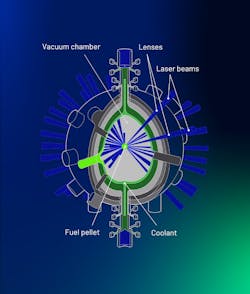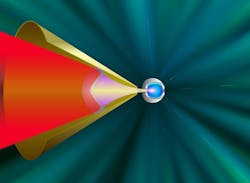Commercializing laser-driven fusion energy by 2030s will ‘take entire village’
Lawrence Livermore National Lab’s National Ignition Facility (NIF) achieved a shot in August 2022 that showed a yield of 1.35 megajoules (MJ) of fusion energy with 1.9 MJ of laser energy—signaling fusion burn had occurred for the first time.
This scientific breakthrough was quickly followed a few months later, in December, by an even more impressive advance: A yield of 3.15 MJ of fusion energy with 2.05 MJ of laser energy. This inertial confinement fusion (a.k.a. laser fusion) experiment attained ignition, which was the long-awaited sign that the thermonuclear fusion reaction that powers the sun, stars, and nuclear weapons can indeed be reproduced within the lab.
“NIF is right on the edge of propagating burn and fusion ignition,” says Todd Ditmire, a physics professor at the University of Texas at Austin, as well as one of the four co-founders of fusion company Focused Energy, which is working to commercialize inertial fusion energy as an energy source.
A small increase in the laser energy from the shot in December “led to a considerable increase in fusion yield. NIF is right on the rising edge—this is an exciting development because it scientifically validates the inertial confinement fusion model of a hot spot in propagating alpha-driven fusion burn. It essentially validates a scientific concept the U.S. has been working on for 40 years.”
“NIF’s big breakthrough gives us confidence in the science aspect of the problem,” says Ditmire. “That said, we still have a long way to go. We need to increase the gain from 1.5 to something like 100 to be commercially viable, but the science of propagating burn has been demonstrated.”
Reaching a gain of 100 will be a challenge, he notes, but they now have a lot more confidence in their quest of commercialization. And yes, of course, daunting engineering aspects will need to be addressed (see Figs. 1-3).“The big challenges in commercializing inertial fusion energy are the many beamlines of kilojoule lasers that fire at roughly 10 Hz, which will need a wall plug efficiency of 10 to 15% (electrical to laser light),” says Ditmire. “And the third big pillar is producing enough targets. At 10 Hz, you need to produce 900,000 targets a day. For NIF, each target takes a long time—weeks—and costs a considerable amount of money. We need to reach the point where we can mass produce targets at 900,000 per day and drop the cost to less than $1/target.”
Laser design on a tight timescale
From a laser standpoint, two major challenges must be overcome on the road to commercializing laser-driven fusion. “The first is to build a laser and a machine to demonstrate high gain ignition,” says Ditmire. “We need to do what NIF did and take it a step beyond—from 1.4 to 10s. Much of my effort, as well as that of my company and partners, is working to design an ignition-scale machine. This isn’t a reactor or a machine to put energy on the grid, it’s to simply demonstrate ignition.”
NIF began its attempt to achieve ignition in 2011 and initially had a very small yield. “It was a beautiful bit of science,” says Ditmire. “If you look at a plot of the yield of every shot they did, the bottom axis is in years and finally at the bottom there’s a big spike in 2022. Their progress was steady and excellent experimental science, but took over 10 years.”
Why did it take 10 years? “It was the shot rate of the laser,” Ditmire explains. “They do an ignition shot once a month, which is based in part of the repetition rate of the laser. One of the big steps we need to take from a laser technology standpoint is to go from a single-shot machine to a machine with enhanced repetition rate. This isn’t a reactor-scale repetition rate, but we need to take an intermediate step so instead of shooting once every few hours we shoot once every few minutes to reduce the time from years to months to achieve a fusion power plant that puts energy on the grid in the 2030s.”Much of the laser work involves getting to the step of an ignition-scale machine. “We’re pursuing solid-state lasers, which is what NIF’s approach is based on,” he says. “But gas laser approaches are being pursued by other companies.”
The second major laser technology advance will build upon work being done at national labs like Livermore to develop the laser technology necessary for a fusion power plant. “It needs to be a diode-pumped solid-state laser or an extremely efficient gas laser that can fire at 10 Hz, be mass manufacturable, and have the same kind of reliability as an industrial welding laser—it needs to run 24/7, have a low failure rate, and be maintainable,” Ditmire says. “It’s a major engineering challenge we need to start to tackle now.”
It will involve a lot of effort in lasers on that front. “We’ll build on laser diode pump technology pioneered by Livermore Lab in the U.S. and Rutherford Lab in the U.K.—taking work currently done at the 100 J, few Hz level, up to the few kJ level at 10 Hz,” he says. “It’s an interesting laser technology and engineering problem.”
Public-private partnerships and funding are critical
Research collaboration between public and private sectors has a very important role to play in getting laser-driven fusion on the grid during the 2030s.
“The help of the U.S. government is crucial to make this happen,” says Ditmire, who is actively explaining the rush and need for funding fusion to Congress. “Making fusion work will ‘take the entire village.’ No single company off working on their own is going to solve fusion. We need the collective expertise of national labs, technology within the private sector, as well as public- and private-sector investments—we need everyone to come together to solve this problem. The problem is so compelling, we need to make fusion energy happen. And it means we need to do business in ways we haven’t before.”
The solution to the tight timeline to reach carbon-free energy needs to involve a combination of public- and private-sector investments—and the U. S. Department of Energy’s (DOE) Office of Science is now stepping up with serious funding for several projects.
One big win for fusion energy is the DOE’s Public-Private Partnership programs. “Congress appropriated $25M in both FY21 and FY22, and the DOE put out a call for proposals last November to fund $50M public-private partnerships,” says Ditmire. “They’ll select between three to five private-sector-led teams to develop a conceptual design for a fusion pilot plant (FPP).”
This involves $50M for the first 18-month phase, and the DOE has announced there will be three phases: the first lasting 18 months, the second lasting 18 months, and the third lasting 24 months. The funding level is still being determined by Congress, and it’s where the serious public money may kick in to help give fusion energy funding the boost it needs.
“We’re lobbying to increase the appropriation to $100M next year, and to grow it from there,” says Ditmire. “This is the avenue from which success will hopefully grow.”
Another recent bit of funding was announced in January 2023, as part of the DOE Office of Science’s Innovation Network for Fusion Energy program [https://infuse.ornl.gov], and it provides $2.3M to researchers at seven private companies. It also gives these researchers access to the expertise and capabilities at DOE Laboratories to help them address critical scientific and technological challenges in pursuit of fusion energy systems.
“In the past, fusion research was purely publicly funded through the DOE’s Fusion Energy Sciences program,” says Ditmire. “We need to demonstrate fusion energy on both the laser and magnetic confinement sides—both are multibillion-dollar machines—so it’s probably beyond the pale for purely public funding on the timescale we’re facing. It means public-private partnerships are going to be the key to being successful.”
Cost challenges
As you’d guess, achieving fusion energy will be costly. The ignition-scale machine Ditmire and Fusion Energy are proposing to build in central Texas to run a credible ignition experiment by the 2030s will cost in the ballpark of $2.5B.
Another effort they’re pursuing is diode-pump laser module development. “It’s a technology demonstrator, which is also the language used in the DOE Basic Research Needs report written by the community about how to move forward on their IFE program,” he explains. “If you were to demonstrate a single diode-pump laser module, it’d essentially be the building block for a fusion power plant. This is an $80M to $100M project being driven to a large extent by the cost of laser diodes.”
Ditmire hopes that within the next few years the cost of laser diodes will continue to drop, which will drive the price of a demonstrator down as well.
A laser-driven fusion future
The NIF result shows fusion energy is “no longer a joke of being 20 years in the future,” Ditmire points out. “For many years, fusion was an abstract idea—but this is no longer the case. We now have a laboratory demonstration of fusion gain, which changes the playing field in so many ways. Private and public sector investments now acknowledge this, and the DOE is changing its vision about how to move forward. These are all exciting developments.”
To commercialize laser-driven fusion, we’ll need to build an entire ecosystem—a huge supply chain for lasers and photonics—to make this vision reality. “It has the potential to be the most important development in lasers and photonics within 20 years,” Ditmire says.
Considerable challenges must be overcome and “this a commercial enterprise addressing the largest market in the world,” he adds. “Wars are fought over the energy market. It’s the most important market, and now we can see a path to a carbon-free source of energy, it may literally democratize energy. The source of the fuel is sea water, which gives us a lot of exciting opportunities to manage the future.”
Can all of these fusion challenges be solved on a timescale to affect climate change? “It remains to be seen—a lot of hard work needs to be done during the next 15 years to make it happen,” Ditmire says.
About the Author
Sally Cole Johnson
Editor in Chief
Sally Cole Johnson, Laser Focus World’s editor in chief, is a science and technology journalist who specializes in physics and semiconductors.



